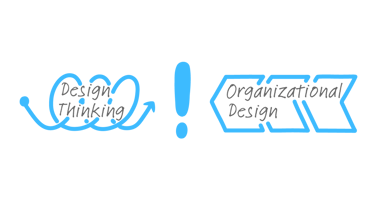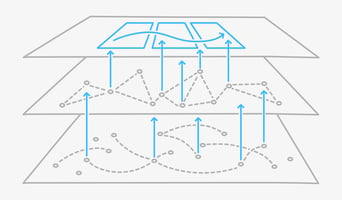Design thinking methods can be powerful tools for organization design work and in collaborative management problem solving. The following user success story highlights two insightful examples of successful design thinking methods that relate to the Organizational Structure Kit.
Understanding management and organization design work as an opportunity to deploy design thinking methods has always been a key proposition of Management Kits.
Two recent examples of Management Kits users working with the Organizational Structure Kit highlight the potential of this connection. Eric Santillan, a Singapore-based organizational psychologist and consultant, chose a collaborative workshop setting when supporting a client in redesigning their operations department. Eric used the Kit as a jumping off point to engage workshop participants with two specific design thinking methodologies, which, in our view, perfectly complement the Kit’s resources, especially when a participatory approach is used.
Draw your perfect organization - from the perspective of an App user
When working on the goals, limits, and principles of organization design, Eric asked his workshop participants to draw their perfect organization, imagining that the organization was an app and that the participants were the users of this organization app.
Eric described his approach as follows:
This was done online, over Zoom. I divided the participants into groups of 5. Each group was assigned a Jamboard (or a miro board) and the links were given beforehand. The whole activity lasted around 45 mins.
For the first 10 mins, the participants were prompted to think about their present organisation. If their present organisation is an app, is it a “fast” app or a slow one? Are there bugs? List down the bugs. This listing is done on the online board.
After listing down the bugs, participants were then prompted to think about their perfect organisation for the next 15 mins: Imagine that organisation as an app, specify its key features. What would that app do very well? Contrast that app with the present organisation: what would it continue to do, what would it stop doing? The questions are on the board and the participants answer them on the board below the questions.
Participants were then asked to do a quick visual walkthrough of the different answers and given time to add to the board. The last 20 mins was given as discussion time among the members about things they want to highlight in their answers.
The result of Eric’s design thinking approach and facilitation: this kind of reframing of “organization” allowed the workshop participants to see their organization design challenge in a new light. For example, it allowed them to define what they need out of the “app” (e.g., what information, which deliverables, which ways to communicate). It can also heighten the awareness of inputs they as users need to give to this “organization as an app”. Requirements for interfaces become more clear. Workshop participants can compare and contrast different perspectives on the “perfect organization”.
A “day in the life of” allows organizational members to capture crucial activities
A second creative extension of the Kit methodology was to work with an adapted “day in the life of” (DILO) method in the activities section of the Organizational Structure Kit.
The activities section of the Organizational Structure Kit serves to establish and (re-)define what the organization as a whole needs to do in order to pursue its strategy on the level of activities. The key is to not miss crucial activities and to capture them on the right level of granularity. This repository of activities is a key input for the unit structuring work and can also be leveraged for sizing and workforce planning in subsequent phases.
Workshop participants representing different functions were asked to capture what they do during a typical work week. Involving functional representatives in this way also strengthens the analysis and buy-in of stakeholders. It makes it easier to identify activities that more desktop-based approaches might easily miss. Based on the involvement of stakeholders - and their belief that their baseline activities are truly understood - it is easier to discuss the pros and cons of different unit structuring options, which often involve a reallocation of activities to or across different units, and thus change.
Eric shared the details of how he skillfully facilitated this during the collaborative session:
I used the DILO in conjunction with a functional representative’s Typical Week. A Google sheet / excel template was given to each of the participants to fill out. It asked them to fill out their typical work day with activities. They were then asked to categorise and group their activities into general themes. In one organisation that just had a functional group visioning activity, they were asked what activities in their DILO and Typical Week add to their Group Vision, and which activities do not add to their Group Vision. You can also ask what percentage of time is spent on doing productive work (one CEO client termed this higher-order thinking work), or doing work for your department (this is an eye opener for some organisations), or especially at this time of online meetings, how much time is spent on meetings.
The results: participants always love this part of the workshop because it acts like a mirror for them on how they spend their time and energies. Without prompting, many participants sum up the number of hours they spend on particular activities (usually the non-productive part of their day). A client resolved to cut down on their online meetings when they found out they spend an average of 3.5hrs on meetings every work day. Because of this activity, another client resolved to bunch activities together (all company meetings to end by 11am, no checking of emails after 2pm, all business development activities to happen on Tuesdays and Wednesdays only, etc.).
More than this eye-opening experience, the activity is a great step in aligning work in the Units section of the Organizational Structure Kit. They can then have a “before” and “after” DILO and Typical Week template when they’re being organised into Units later on.
Overall, organization design approached in this way complements functional perspectives on organizing that follow a human-centered approach.
Boost organizational effectiveness
with Management Kits
We are grateful to Eric Santillan for sharing his experience and his creative approach towards organization design when working with Management Kits. You can contact Eric via LinkedIn.



